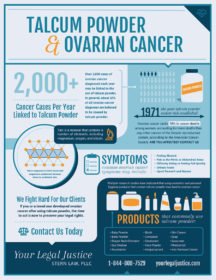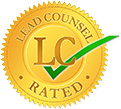Talcum Powder Lawsuit Infographic
Talcum Powder & Ovarian Cancer
Multiple research studies have indicated that using cosmetics and personal hygiene products that contain talcum powder may lead to ovarian cancer. Many talcum powder manufacturers, including Johnson & Johnson, downplay the risks as women continue to unknowingly expose themselves to a higher risk of contracting ovarian cancer.
The Problem
Research suggests that women who apply talcum powder regularly in the genital area (or on sanitary napkins, diaphragms or condoms) have an increased risk of ovarian cancer. Talc is also used in a variety of other feminine cosmetics and makeup.
Ovarian cancer ranks fifth in cancer deaths among women, accounting for more deaths than any other cancer of the female reproductive system, according to the American Cancer Society.
Talc is a mineral made up mainly of the elements silicon, magnesium and oxygen. Asbestos, a known carcinogen, is a similar silicate mineral often found together with talc in the earth. Some talc used in consumer products may contain asbestos.
Inhaling talc in personal care products can also lead to respiratory disease characterized by labored breathing and coughing. The National Institute for Occupational Safety and Health says long-term exposure to talc can cause talc pneumoconiosis.
The Evidence
Scientific literature dating to the 1960s has suggested an association between the use of powders containing talc and ovarian cancer, according the Food and Drug Administration.
A 2016 study by researchers at Brigham and Women’s Hospital in Boston and the Harvard School of Public Health determined that genital use of talc, either alone or in combination with body use, was associated with elevated risk of ovarian cancer.
Pooled results of similar studies involving nearly 20,000 women found body powder use was associated with a 24% increased risk for ovarian cancer.
Eight studies reviewed for a 2010 monograph by the World Health Organization International Agency for Research on Cancer indicated a 30 to 60% increase in risk for ovarian cancer among users of body powder vs. non-users.
A 1997 study by the Fred Hutchinson Cancer Research Center, Seattle, WA, published in the American Journal of Epidemiology found an elevated relative risk of ovarian cancer in women with a history of perineal dusting with talcum.
A July 1992 study published by the American College of Obstetricians and Gynecologists found that among women with perineal exposure to talc, the risk of ovarian cancer was significantly elevated among women who applied it directly as a body powder on a daily basis for more than 10 years.
Heightened Concern for African American Women
A 2016 American Association for Cancer Research study of African-American women, a group known to favor use of body powders, concluded that body powder use was significantly associated with a risk of invasive epithelial ovarian cancer. Users of genital powder had more than a 40 percent increased risk of ovarian cancer. Those who used only non-genital powder had an increased risk of more than 30 percent.
In the 1990s, Johnson & Johnson outlined a plan to hike flagging sales of its powder “by targeting” black and Hispanic women, according to a company memorandum made public in recent lawsuits leading to multimillion-dollar verdicts against the powder manufacturer. — Reuters Health News
Feminine Consumer Products Containing Talc
Body Powder
- Johnson’s Baby Powder
- CVS Brand Baby Powder
- Rite Aid Baby Powder
- Anti Monkey Butt Powder
- Assured Shower & Bath Absorbent Body Powder
- Angel of Mine Baby Powder
- Family Dollar Mild Baby Powder
- Shower to Shower Morning Fresh Absorbent Body Powder
Face Powder
- LA Colors Pressed Powder
- Revlon Color Stay Pressed Powder
- Cover Girl TruBlend Mineral Loose Mineral Powder
- Physician’s Formula Summer Eclipse Bronzing & Shimmery Face Powder
- Wet n Wild Bronzer
- Iman Luxury Pressed Powder
- Coty Air Spun Loose Face Powder
- Black Opal Color Fusion Powder
- Black Radiance Pressed Powder
- Posner Finishing Touch Pressed Powder
- N.Y.C. New York Color Loose Face Powder
- Almay Nearly Naked Loose Powder
- Clinique Stay Matte Sheer Pressed Powder
- BeneFit Hello Flawless Custom Powder Cover-Up for Face SPF 15
- Smashbox Fusion Soft Lights Intermix Pressed Powder
- Guerlain Meteorites Poudre de Perles Illuminating Perfecting Pressed Powder
- Urban Decay Baked Bronzer
Foundation
- Black Opal True Color Liquid Foundation
- Laura Mercier Foundation Powder
Eye Shadow
- Physician’s Formula Shimmer Strips Custom Eye Enhancing Shadow & Liner
- Black Radiance Eyeshadow Quartet
- Stilla Eye Shadow Trio
- Dior 5-Colour Iridescent Eyeshadow
Blush
- Maybelline New York Expert Wear Blush
- N.Y.C. New York Color Cheek Glow Powder Blush
- NARS Blush
Symptoms of Ovarian Cancer
The American Cancer Society says women are more likely to experience symptoms of ovarian cancer only after the disease has spread beyond the ovaries, though even early-stage ovarian cancer can cause symptoms.
Women should see a gynecologist if they experience persistent (more than 12 times a month) and changed symptoms related to:
- Abdominal bloating
- Pelvic or abdominal pain
- Trouble eating or feeling full quickly
- Urinary urgency or frequency
- Changes in bowel habits, such as constipation.
Additional symptoms that may be caused by ovarian cancer include:
- Fatigue
- Upset stomach
- Back pain
- Pain during sex
- Menstrual changes
- Abdominal swelling with weight loss.
If you have a family history of ovarian cancer or breast cancer, talk to your doctor about your risk of ovarian cancer, the Mayo Clinic advises.














